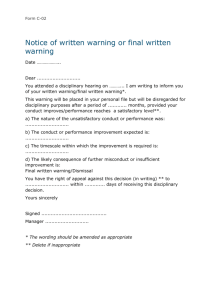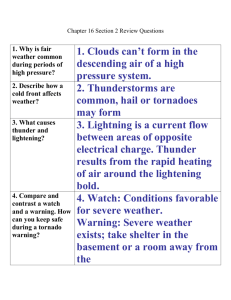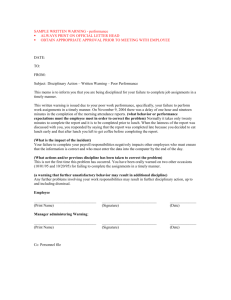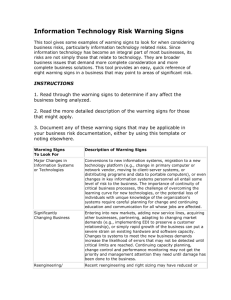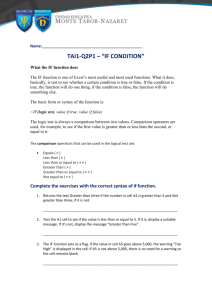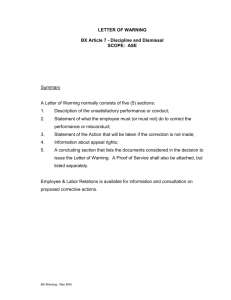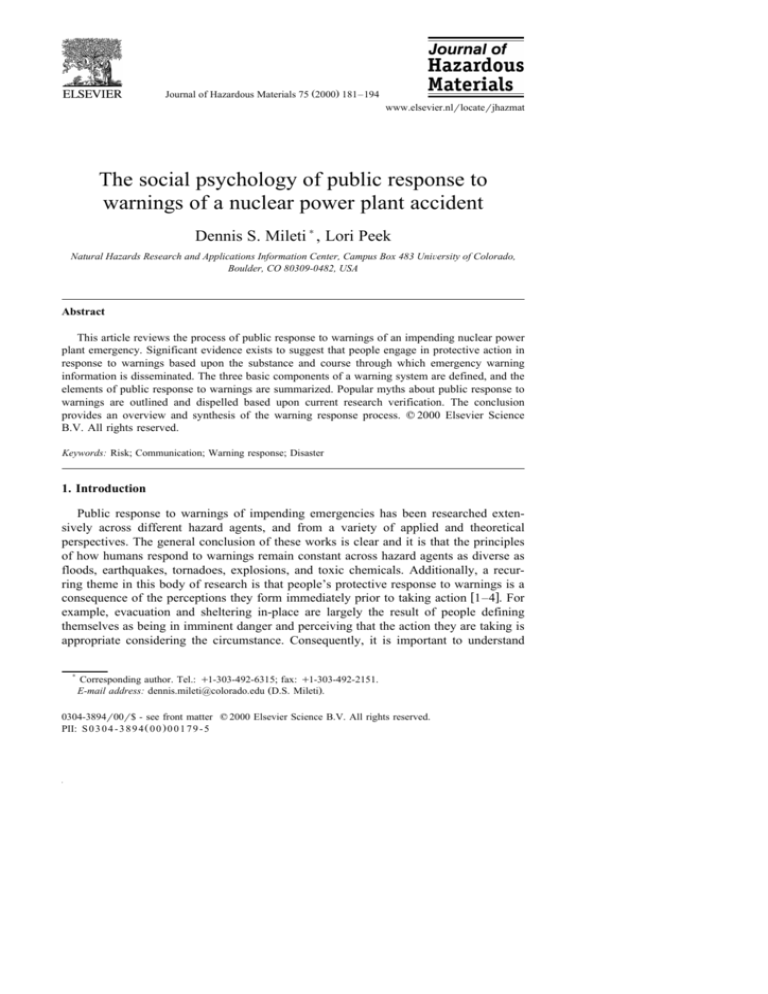
Journal of Hazardous Materials 75 Ž2000. 181–194
www.elsevier.nlrlocaterjhazmat
The social psychology of public response to
warnings of a nuclear power plant accident
Dennis S. Mileti ) , Lori Peek
Natural Hazards Research and Applications Information Center, Campus Box 483 UniÕersity of Colorado,
Boulder, CO 80309-0482, USA
Abstract
This article reviews the process of public response to warnings of an impending nuclear power
plant emergency. Significant evidence exists to suggest that people engage in protective action in
response to warnings based upon the substance and course through which emergency warning
information is disseminated. The three basic components of a warning system are defined, and the
elements of public response to warnings are summarized. Popular myths about public response to
warnings are outlined and dispelled based upon current research verification. The conclusion
provides an overview and synthesis of the warning response process. q 2000 Elsevier Science
B.V. All rights reserved.
Keywords: Risk; Communication; Warning response; Disaster
1. Introduction
Public response to warnings of impending emergencies has been researched extensively across different hazard agents, and from a variety of applied and theoretical
perspectives. The general conclusion of these works is clear and it is that the principles
of how humans respond to warnings remain constant across hazard agents as diverse as
floods, earthquakes, tornadoes, explosions, and toxic chemicals. Additionally, a recurring theme in this body of research is that people’s protective response to warnings is a
consequence of the perceptions they form immediately prior to taking action w1–4x. For
example, evacuation and sheltering in-place are largely the result of people defining
themselves as being in imminent danger and perceiving that the action they are taking is
appropriate considering the circumstance. Consequently, it is important to understand
)
Corresponding author. Tel.: q1-303-492-6315; fax: q1-303-492-2151.
E-mail address: dennis.mileti@colorado.edu ŽD.S. Mileti..
0304-3894r00r$ - see front matter q 2000 Elsevier Science B.V. All rights reserved.
PII: S 0 3 0 4 - 3 8 9 4 Ž 0 0 . 0 0 1 7 9 - 5
182
D.S. Mileti, L. Peek r Journal of Hazardous Materials 75 (2000) 181–194
the fundamental process whereby people define reality in order to understand how they
respond to warnings since they act on these definitions in attempting to create their
desired reality.
A basic point to bear in mind is that the process of forming perceptions is an ongoing
human activity that is fundamental to, and transcends, all social life. That is, the
perceptions that are formed in emergencies follow the same processes as those formed in
response to any other social event. In this general perceptual process, new stimuli or
motivations are continuously introduced into people’s perceptual fields — what people
perceive in the moment. Any encountered situation perceived as needing immediate
attention engages people in active problem solving w5x. The definition of the situation
that is necessary prior to any willful act arises from the presented event, but it also is
affected by relevant beliefs, understandings, expectations based on past experience in
similar situations, and cues from various events including the behavior of other persons
in the immediate environment w6x. Moreover, the definition of the situation also is
affected by defining attributes of the general public Ži.e., economic, social, religious,
educational, experiential, cognitive, and so on.. Finally, the process is dynamic because
perceptions are processed and reprocessed to fit into a context of reality. That is, what
people think is real is their own reality and it changes over time.
There is significant research evidence supporting the applicability of this model in
understanding how people become motivated to engage in protective action. Moreover,
this research suggests that the communication process by which emergency warnings are
disseminated plays a key role in the definition of risk perceptions w7–9x. Thus, the intent
of this paper is to show how this model of perception formation affects public response
to warnings of a nuclear power plant emergency.
2. Definition of a warning system
Warning systems consist of three basic components: a detection subsystem, an
emergency management subsystem, and a public response subsystem w10x. The first
stage in the warning system is the detection of a hazard; that is, the recognition that an
abnormal conditions exists. Once the hazard is detected, the second key step is to
determine whether or not the hazard poses a significant threat to public safety. These
stages are chiefly the responsibility of the personnel at the nuclear power plant. Once a
threat is judged to be significant, the assessor then must determine who should be
notified of the threat. The notification of a public official typically results in the
activation of an emergency response system. The organization initially notified must
decide whom else to involve in assessing the situation. Once mobilized, emergency
managers must decide whether the risks warrant issuing a warning and, if so, what
mechanisms must be used to warn the public? Finally, emergency managers must decide
what type of protective action is needed. Even if the threat is simple and will impact
only a small area, this decision-making process is likely to be interactive and contains
numerous dynamic communication flows. As such, the model implicitly recognizes the
need for integration among the sub-components, the need for timely and effective
communication linkages, and the importance of decisions, including those associated
with protective response.
D.S. Mileti, L. Peek r Journal of Hazardous Materials 75 (2000) 181–194
183
An important consequence of this model is that the link between a nuclear power
plant and the population at risk is not direct. Warning decisions usually are made by
state, city, or county officials. The first step of a warning is the off-site notification of
the appropriate community officials or point of contact. This step can be accomplished
in a number of ways. Conventional communication systems, such as telephone and
radio, are not viewed by experts as highly reliable forms of communication. Telephones
can fail Žsometimes from the same event that caused the emergency. or may be busy.
Radios often operate at different frequencies, are inoperable, or are difficult to use
because of heavy traffic on the appropriate frequency. As a result, communication
systems must be designed to overcome such problems. These include dedicated telephone lines Žseparate lines not linked with commercial traffic., dedicated radios, pagers,
and special alarm systems. Such systems are required by federal agencies and have
become standard practices in the nuclear industry w11x. New technologies are being
developed and implemented that can provide even greater reliability. These include fiber
optic networks to exchange data, satellite communications, and microwave radios.
Good communication extends beyond hardware. One of the better predictors of good
communication in an emergency is the quality of interpersonal interactions during
normal times. People who know each other will work together in a crisis w12x. Another
predictor of effectiveness is knowing who will be communicating with whom during an
emergency as well as what they will be communicating about. One way to promote good
communication is to conduct practice exercises on-site. Another way is to get people in
the system to know one another in a less formal manner. For example, recreational
sports teams or social events are mechanisms used to build cohesiveness and improve
interpersonal communication.
3. The elements of public response to warnings
3.1. The general process
Research findings suggest that people who receive emergency warnings go through
the process described above in a sequential process that shapes their perceptions and
subsequent actions andror behavior. This process is the sequence hear–perceive Žunderstand, believe, and personalize. –respond Ždecide about alternative protective actions and
perform them..
The first stage, hearing the risk information, depends upon the areal extent of warning
dissemination and ambient conditions within the warning zone w13x. For example, sirens
might not be able to be heard if there is a strong wind and, especially, if people are
indoors with noisy air conditioning or other equipment operating.
In the second stage, the risk information must be understood. Understanding is not
meant to refer simply to interpretation, but also to the attachment of meaning to the
information. Those meanings can vary among people and may or may not conform to
the understandings intended. A 50% probability may be interpreted as almost certain by
some or relatively unlikely by others. In this sense, understanding includes the perception of risk. The third stage is belief in the risk information and in the accuracy of what
184
D.S. Mileti, L. Peek r Journal of Hazardous Materials 75 (2000) 181–194
is being communicated; in this way, belief also includes risk perception. The fourth
stage is the personalization of risk; that is, the perceived implications of the risk being
communicated on the receivers themselves; thus, personalization also encompasses risk
perception.
The fifth stage involves people deciding what to do about the risk, while the sixth
involves performing that behavior. Throughout the warning Žrisk information communication. period, a person typically goes through the stages of the model each time that
new information is received. Thus, response to a warning message follows from a series
of decisions. The formation of a risk perception is not a solitary event resulting from a
single communication but instead is the result of an emerging process. Additionally,
people do not passively await the arrival of more information; most people actively seek
it out. This results in what has typically been referred to as the warning confirmation
process w1,14x. This sequence and its human action outcomes are impacted by three
categories of factors. The first is the content of the warnings received, the second is the
style of the warning messages received, and last consists of warning recipient characteristics.
3.2. Warning message content
Information presented in a person’s environment acts as a stimulus or motivation to
engage in the process of forming perceptions about a given situation. Information about
a hazard and recommended protective action becomes a dominant stimulus setting
people off on a course of forming a risk perception. Several information-specific factors
have been demonstrated to shape an endangered public’s perception of risk and
subsequent actions aimed at resolving the presented problem. In an emergency, information factors can strongly and directly influence people’s formation of a belief that the
danger is real, needs special attention, and may require a protective response such as
evacuating or sheltering in-place. These factors are largely related to qualities of the
message; they are important to consider when understanding the determinants of human
response in the risk communication process. Five specific topics are important to include
in assembling the actual content of a public warning message. These topics are hazard,
location, guidance, time, and source.
3.2.1. Hazard
A warning message must provide the public with information about the impending
hazard that has precipitated the emergency warning. Every warning should consist of
two parts: a description of the event that is expected to occur and an explanation of how
it is a threat to people’s safety. For example, it is not adequate for a warning message to
state simply that radioactive material might soon escape from the nuclear power plant.
Such a warning would leave the hazard in a ‘‘black box.’’ Instead, the warning must
describe the character of the impending hazard. For example, one might say that rising
pressure in the containment building might cause an explosion that would destroy the
protective seals around the control cables into the reactor building. This would allow
radioactive material to be released into the air like a cloud and dissipate as it travels
downwind. If a hazard is well described, people are better able to understand the logic of
D.S. Mileti, L. Peek r Journal of Hazardous Materials 75 (2000) 181–194
185
protective actions — close the car windows while evacuating because the risk is in the
air, get out of the streets because it is safer in a building basement, and so on.
The general principle to be observed when describing a hazard is that a warning
message should provide enough detail for all members of the public to understand the
physical character of the hazard agent from which they are to protect themselves.
Vagueness in warning messages will result in different members of the public defining
the hazard in different ways and then responding in ways consistent with those different
definitions. Informing the public about the physical characteristics of the hazard in
warning messages will minimize the likelihood of people misperceiving the hazard and
subsequently making incorrect decisions about what to do.
3.2.2. Location
Warnings also must include the location of the impending hazard because the degree
of risk is a function of proximity to it. Warnings must define the location of who is not
at risk as well as those who are at risk, and this should be done in ways readily
understandable to those who are intended to receive the warning. For example, a
warning could say, ‘‘the area of town that will be affected will be between Second and
Fifth Streets from Elm Avenue to Magnolia Boulevard.’’ In many cases, messages also
should be directed toward other residents who are safe because researchers have found
that some of them also will take protective action w13x. This is particularly important if
evacuation by those who are not at risk might overload evacuation routes and the
resulting traffic jams would endanger those who are closer to the source of danger. Such
messages should say, for example, ‘‘People who live in other parts of the city will not
experience any danger,’’ and then the warning should explain why.
3.2.3. Guidance
It cannot be assumed that the public will know what would constitute an appropriate
protective action. Thus, the content of an emergency warning message must include
information about what people should do to protect themselves from the impending
hazard — a protective action recommendation ŽPAR.. The recommended protective
action must be described in detail. Although this point might seem obvious, it is not.
Warnings, for example, must do more than tell people in danger that they should
evacuate. For some, evacuate may be to the front yard. Instead, the evacuation route,
destination, and Žfor those who lack their own vehicles. method of transportation should
be clearly defined w13x. For example, people might be told to ‘‘evacuate north on
Highway 31 until you have reached Safe Haven City’’ or ‘‘walk to the nearest
elementary school and a bus will pick you up to take you to Safe Haven City.’’ In the
case of sheltering in-place, guidance should instruct people to ‘‘go indoors, shutting
doors, windows, and chimney flues, and turning off heaters or air conditioners.’’
3.2.4. Time
The content of public warnings also must address the timing of public response. It is
important to inform warning recipients about how much time there is before impact so
they will know how much time they have to implement protective actions. For example,
a message might say that ‘‘the plant conditions will not be serious before 10:00 p.m. this
186
D.S. Mileti, L. Peek r Journal of Hazardous Materials 75 (2000) 181–194
evening, but to be on the safe side, you should be past the eastern border of the county
line by 9:45 p.m.’’
Frequency, or the number of times a warning message is delivered, affects hearing,
understanding, and belief. Numerous studies underscore the importance of repeatedly
hearing a message as a condition for adaptive risk perception and response w2,15–19x.
Frequently repeated messages help to reduce the potential for public misperceptions by
focusing people on official warnings, reducing rumors, and increasing public confidence
in the validity of the warnings. In protracted emergencies, there might be a point of
diminishing returns after which constant delivery of new information may be counterproductive. However, research indicates that people will patiently monitor a threatening
situation for quite a while before losing interest. For example, most residents of the area
around Mt. St. Helens monitored the radio four times a day or more for weeks after that
volcano first became active w20x.
3.2.5. Source
The final dimension of a warning is the warning source. The source of a PAR shapes
the perceptions of risk that the public form. Information from credible and reliable
sources encourages information believability. Thus, the source should be identified in
the warning message and be as much a component of it as is information about hazard,
location, guidance, and time. Since people have different views about who is credible
and who is not, PARs that come from a mix of scientists, reputable organizations, and
public officials serve to facilitate perceived belief w1,8,21x. For example, ‘‘the mayor and
the head of civil defense have just conferred with scientists from our local university and
the Nuclear Regulatory Commission, as well as the head of our local Red Cross chapter,
and we now wish to warn you that’’
3.3. Warning style
Each of the five parts of warning message content Žhazard, location, guidance, time,
and source. is readily juxtaposed against the dimensions of warning style that research
suggests facilitates adaptive public warning response. These include specificity, consistency, certainty, clarity, accuracy, sufficiency, and channel. A description of these
follows.
3.3.1. Specificity
Public understanding of communicated emergency information is enhanced if it is
specific regarding the nature of the hazard agent, the risks of unprotected exposure, the
location at risk, the recommended protective action, and the amount of time available
before impact. All of these have been found to influence public personalization of the
risk and subsequent response to the hazard w2,16,22–28x. Obviously, specificity on all
content items cannot be high on many occasions because they are unknown or are
known imprecisely. Even on these occasions, however, the warning message itself need
not be nonspecific. Furthermore, the style with which it is written must remain specific.
For example, a recommendation to shelter in-place might say that ‘‘we are unable to say
which buildings in the city are the safest, but we do know that residents of the following
communities will be protected best if they stay inside and do not attempt to evacuate.’’
D.S. Mileti, L. Peek r Journal of Hazardous Materials 75 (2000) 181–194
187
Clearly specifying the location of danger in a warning message is important in
facilitating public belief and personalizing risk. Location-specific messages lead to
greater levels of personalized risk in the public w28,29x. Detailing the locations at risk is
best done by reference to landmarks that are readily identifiable to the public Že.g.,
highways, political boundaries, and rivers..
3.3.2. Consistency
The style of warning messages also must be one of consistency, both within messages
and across different messages. A warning message promotes the formation of accurate
perceptions if it is consistent in the information it provides with other publicly
announced advisements w1,25,27,30–33x. Consistency was a problem during the accident
at Three Mile Island, where over 10 times as many people evacuated as were advised to
do so w34x. Of the evacuees, 83% cited confusing and conflicting information as a reason
for leaving w22x.
Inconsistencies can exist within a message for a variety of reasons and in many
different ways. For example, it is inconsistent to tell the public that a nuclear power
plant accident may result in a release of radioactive material but that they should not
worry. However, it would be consistent to recommend that they monitor the situation for
further information. Inconsistencies across different warning messages arise in most
emergencies as more is learned about an impending hazard and updates are issued to the
public. Inconsistencies can appear, for example, as new information reveals that the
actual character of the hazard has decreased or increased, the number of people at risk
has become larger or smaller, and so on. In such circumstances, consistency can be
increased across messages simply by repeating what was last said, what has changed,
and explaining why the situation has changed.
3.3.3. Certainty
Third, the style of a warning message is best if it demonstrates certainty about the
factors about which it is conveying information. When there are low probabilities or
ambiguities associated with a hazard’s impact, the message should be stated with
certainty Ževen about the ambiguity.. For example, ‘‘there is no way for us to know if
there really is going to be an explosion in the reactor, but we have decided to act upon
the potential for an explosion by recommending that all those within 2 mi of the nuclear
power plant evacuate now.’’
Certainty in warning messages extends beyond actual message content and also
includes the style of delivery. The warning should be spoken by a source delivering the
message in a tone which conveys that hershe believes or is certain about what is being
said. Public information enhances PAR compliance if it conveys a high level of certainty
about the events taking place and what people should do. Even in an ambiguous
situation a message stated with certainty will impact public belief in the message and
affect decision-making w9,20x.
3.3.4. Clarity
Clarity, a fourth style attribute of warning messages, simply means that warnings
must be worded clearly in simple, straightforward language that can be understood by
188
D.S. Mileti, L. Peek r Journal of Hazardous Materials 75 (2000) 181–194
the general populace. For example, ‘‘a possible transient excursion of the reactor may
result in a sudden relocation of the core materials outside the reactor vessel’’ would
better be clarified by stating, ‘‘radioactive materials are likely to be released from the
nuclear reactor.’’ A warning message that advises protective action by the public must
be worded in simple language so that it can be understood w27x. Lack of clarity can lead
to public misunderstanding of the message w21,35x.
3.3.5. Accuracy
The fifth style attribute of warning messages is accuracy. Warning messages can vary
in the extent to which their content is perceived to be accurate in terms of hazard,
location, guidance and time. Such perceptions have been found to cause people not to
believe what they hear w14x. If people suspect that they are being lied to, or even that
they are not receiving the whole truth, they may well lose the ability to believe further
messages from that source. Perceived accuracy is enhanced simply by being fully open
and honest with the public from the outset of an emergency.
3.3.6. Sufficiency
Sufficient information in a message facilitates the formation of sound public perceptions of exactly what is happening and what to do. Insufficient information creates
confusion and uncertainty. Too much detail may be overwhelming. The amount of
information provided affects understanding, personalization, and belief. For example, a
study of family response to natural disaster warnings found that general and vague
messages caused people not to take protective actions w36x. Conversely, a study of
response to the Mt. St. Helen’s eruption found that detailed information led to higher
levels of perceived risk and a greater likelihood of public protective action being taken
w29x.
3.3.7. Channel
The avenues through which the information is delivered shapes public perception and
action. Warnings can be issued to the public in a variety of ways: voice, electronic
signals, or in print. Voices can be direct or broadcast over loudspeakers, public address
systems, telephone, radio, or television. Signals include sirens, alarms, whistles, signs,
and lights. Leaflets, brochures, or video can be used to distribute graphic information
and printed messages. Information communicated over multiple channels, such as
printed and electronic media or personally delivered, has been demonstrated to enhance
public understanding, belief, and response w2,9,22,24,28,37x.
3.4. ReceiÕer characteristics
Information factors affecting public response to warnings do not operate in isolation.
Research shows that warning response is affected by a variety of characteristics of the
warning recipients. These factors, which people bring to an emergency, fall into six
categories.
3.4.1. Cues
Environmental cues, which are the physical characteristics of the setting in which the
public receives emergency information, interact with the information factors previously
D.S. Mileti, L. Peek r Journal of Hazardous Materials 75 (2000) 181–194
189
described. For example, it is more difficult to get a public to believe a flood warning on
a sunny day or if neighbors are not seen leaving in concert with receiving evacuation
instructions. Location of the risk or geographical proximity of those at risk to the
impending threat is another physical factor that affects the perception formation process
w38–40x. Such environmental cues impact the perceptions of understanding, believing,
personalizing, as well as actual action w1,14,22,27,41,42x.
3.4.2. Social setting
Social setting factors include whether or not the family is united when the warning is
delivered, what activities are being performed at that time, and what others are doing to
respond. Social setting factors affect public belief and action w21,22,30,43,44x. Mack and
Baker w45x, for example, reported that family unity at the time of a warning increases the
likelihood of belief; and Drabek and Stephenson w21x similarly noted that families who
are united at the time of a warning are more likely to respond to the warning. In
addition, the evacuation of neighbors and friends is a major influence on the decision to
evacuate w41x.
3.4.3. Social ties
Social ties also affect perceptions and evacuation w8,30,46,47x. Perry w52x, for
example, found that as family cohesion increased, the likelihood of evacuating in
response to a flood warning concomitantly increased. Alternatively, knowing someone
who worked at Metropolitan Edison was related to decisions not to evacuate during the
TMI emergency w48x.
3.4.4. Social structure
Characteristics of the risk area population — such as resources, gender, or socioeconomic class — can influence understanding, belief, personalization, and response
w9,22,28,49–52x. For example, in an analysis of the TMI accident, Sorensen and
Richardson w48x found that older people were less likely to evacuate. While not well
understood, gender has also been found to be related to warning belief. Women are more
likely to believe a warning than men w1,9,51x.
3.4.5. Psychological factors
Psychological characteristics such as cognitive abilities or personality can influence
how a warning is interpreted. Limitations in cognitive abilities can be a constraint to
accurate perceptions if people are provided with too much information w9,22,52–54x.
Personality also is related to perception formation and action. The personality factor
investigated most extensively in the context of warning response is locus of control.
Simply stated, people with an internal locus of control are self-determined and tend to
feel they have control over their fate w55x. Conversely, people with an external locus of
control have fatalistic views of the world and feel their fate is in the hands of chance,
powerful others, or ‘‘divine power.’’ Those with an internal locus of control are more
likely to believe, personalize, and respond to a PAR than the latter w9,22,23x.
190
D.S. Mileti, L. Peek r Journal of Hazardous Materials 75 (2000) 181–194
3.4.6. Pre-warning perceptions
People filter information to conform with their pre-existing views of the world.
Consequently, preconceived ideas of an emergency can impact situational perceptions of
risk. If their perceptions of the hazard are inaccurate, people may disregard warnings
w8,17,22,56,57x or respond unnecessarily w57x. Moreover, people who have erroneous
beliefs about protective actions may fail to comply with official PARs w58x.
3.5. Myths about public response to warnings
After examining the extensive amount of information available concerning warning
systems and public response to warning, one would think that most popular myths
surrounding public response to hazard warnings would be dispelled. In reality, this is not
the case. Not only the general public, but surprisingly many emergency managers as
well, believe in a set of widespread myths about public response to warnings. Unfortunately, the belief in these myths often constrains the effectiveness of warning systems
when they are used. Consequently, it is important that those who design and implement
warning systems should not fall prey to these myths. Several popular myths can be
dispelled as follows.
3.5.1. People panic
First, it cannot be overemphasized that the public simply does not panic in response
to warning of impending disasters, including nuclear power plant accidents. This myth is
largely the result of movie producers who depict masses of screaming, fleeing, completely panicked individuals in dangerous scenarios. This is not to say that people never
panic, but panic only occurs in very particular circumstance that rarely, if ever, can be
found in an actual emergency. These conditions include people being in a closed room
with an immediate and clear source of death, and the presence of an escape route for
which it is obvious that there is insufficient time for everyone to escape with their lives.
Note that panic behavior is different from elevated stress, which is a psychological
response that the public and media often label as panic. The negative consequence of the
myth of panic is that warning officials are reluctant to tell the truth or may withhold
warning information because they are afraid of causing panic. As discussed earlier,
people typically respond to warnings by doing everything in their power to obtain more
information. Thus, withholding information from the public — whether that information
is good or bad — is quite detrimental to the overall warning process.
3.5.2. Warnings should be short
The public rarely, if ever, gets too much emergency information in a warning w18x. It
is true that people do not remember all the information contained in a warning if they
hear it only once. Thus, detailed messages can and should be repeated in an emergency.
Warning messages simply are not subject to the 30-s rule known to operate in
advertising attempts to sell consumer products. People are ‘‘information hungry’’ in an
emergency, and they should be provided with all the information they need. This myth is
often reflected by the terse message protocols that are designed to guide information
dissemination in an emergency. There is no evidence whatsoever in the extensive body
D.S. Mileti, L. Peek r Journal of Hazardous Materials 75 (2000) 181–194
191
of research on warning response that a message was so lengthy that it exceeded warning
recipients’ attention spans.
3.5.3. False alarms are problems
The effectiveness of people’s responses to warnings is not always diminished by what
has come to be labeled the ‘‘cry wolf’’ syndrome. Two issues regarding false alarms are
significant. The first concerns a false alarm that leads to public response, such as an
evacuation. In this case, the integrity of the system will be preserved if the reasons for
the mistake are clearly communicated to the public w59x. The second concerns repeated
activation of the alert mechanisms. If such false alarms occur and no attempt is made to
explain why they were false alarms, subsequent public response to the alert of an event
could be affected negatively w60x. This is particularly true of inadvertent sounding of
sirens; people eventually will ignore the sirens in a true emergency if such malfunctions
are frequent and not explained. However, if false alarms are explained, they can actually
enhance public hazard awareness and ability to process risk information during later
warning events. As such, many false alarms are better viewed as opportunities than as
problems. A good emergency plan will have a procedure for explaining false alarms.
Decision-makers should also be assured that the public prefers to err on the side of
caution.
3.5.4. A single spokesperson is necessary
People at risk who are the targets of emergency warnings want information from a
variety of sources rather than from a single spokesperson w61x. This procedure helps
individuals to Ž1. confirm the warning information and the situation; and Ž2. believe the
content of the warning message. However, different or conflicting warning messages
from multiple spokespersons are not desirable. Consistency could be achieved in one of
two ways. Different spokespersons could all deliver the same message, or a panel of
spokespersons could deliver a warning a multiple set of times.
3.5.5. People take protectiÕe action immediately after the first warning
People simply do not take action in response to warning messages as soon as they
hear the first warning w2x. Instead, people seek more information about the impending
hazard and appropriate responses from those they know personally, from the newsmedia,
and from authorities. People call friends, relatives, and neighbors to find out what they
plan to do, and they also turn on the radio and television to get more information. Unless
there is a clear explanation of the need for an immediate response, they might wait for a
second, third, or fourth official warning before responding. For this reason, a good
warning plan should call for frequent messages in the early stages of emergencies.
3.5.6. People automatically follow instructions
Contrary to popular belief, people are most likely to follow instructions in a warning
message only if the basis for the instruction is given in the message and that basis makes
sense to them w62x. If instructions in an official warning are not clear and readily
understandable, people typically will behave according to other information sources that
do make sense. Warning messages should clearly define the rationale for all recommended actions.
192
D.S. Mileti, L. Peek r Journal of Hazardous Materials 75 (2000) 181–194
3.5.7. People remember siren patterns
Last, people typically do not remember what various siren signal patterns mean but
will try to find out the reason for a siren sounding if it continues or is repeated. Sirens,
therefore, are best used as signals for the public to seek out emergency information
rather than as signals that should elicit specific protective actions. For example, it would
be inappropriate to use a steady tone to indicate an evacuation and an undulating tone to
indicate sheltering in-place. An exception may occur when there are frequent siren drills
that allow responses to become automatic. This may be of use in work or school settings
or in special situations that can be supported by an intensive education program, but
would be inappropriate for the general public.
3.6. OÕerÕiew and synthesis
The receipt of information from authorities does not directly stimulate action. Instead,
it initiates an intervening process of perception formation within which a process of
interpretation occurs simultaneously. This process of interpretation, or actively defining
the threat as real, is guided by the stimulations, cues, suggestions, and definitions people
secure from their environment w63x. It is within this context of interpretation and
perception formation that a sense of reality is developed and frames of action are created
w5,63–70x. This interpretation stage of the perception formation process is the point at
which the warning message being disseminated to an endangered public has the
potential to strongly influence perceptions of risk.
The public’s perceptions of risk are influenced significantly by characteristics of
authorities’ warning messages. Although information and contextual factors jointly
affect risk perception and response, the information in warning messages can come to
exercise a dominant influence on risk perception if it is formed according to the message
style factors outlined in the previous sections. In particular, research has demonstrated
that specific, consistent, certain, clear, accurate, and sufficient information can promote
the development of an appropriate definition of the situation. Moreover, a warning
message will be most effective when information is repeatedly and consistently delivered and when it enters into the informal communication processes that are stimulated
by the warning confirmation process operating within the risk area population. By
guiding the warning recipients’ definition of the situation, authorities can maximize
compliance with the PARs that are most likely to successfully protect an endangered
public.
References
w1x
w2x
w3x
w4x
w5x
T.E. Drabek, Social Problems 16 Ž1969. 336.
D.S. Mileti, E.M. Beck, Communication Research 2 Ž1975. 24.
R.W. Perry, The Social Psychology of Civil Defense, Lexington Books, Lexington, MA, 1979.
J.H. Sorensen, Environment and Behavior 15 Ž1985. 438.
W.I. Thomas, F. Znaniecki, in: T.M. Newcomb, E.L. Hartley ŽEds.., Readings in Social Psychology,
Henry Holt, New York, 1947.
w6x W.I. Thomas, D. Thomas et al., The Child in America, Knopf, New York, 1928.
D.S. Mileti, L. Peek r Journal of Hazardous Materials 75 (2000) 181–194
193
w7x H. Kunreuther, Disaster Insurance Protection: Public Policy Lessons, Wiley, New York, 1978.
w8x D.S. Mileti, J.R. Hutton, J.H. Sorensen, Earthquake Prediction Response and Options for Public Policy,
University of Colorado Institute of Behavioral Science, Boulder, CO, 1981.
w9x R.H. Turner, J.M. Nigg, D. Paz, B.S. Young, Community Response to Earthquake Threats in Southern
California, University of California Press, Los Angeles, 1981.
w10x J.H. Sorensen, B.M. Vogt, and D.S. Mileti, Evacuation: An Assessment of Planning and Research, Report
ORNL-6376, Oak Ridge National Laboratory, Oak Ridge TN, 1987.
w11x US Nuclear Regulatory Commission, Criteria for Preparation and Evaluation of Radiological Emergency
Response Plans and Preparedness in Support of Nuclear Power Plants, NUREG-0654rFEMA-REP-1
ŽRev. 1., Author, Washington DC, 1980.
w12x D.S. Mileti, J.H. Sorensen, in: N. Weinstein ŽEd.., Taking Care: Why People Take Precautions,
Cambridge Univ. Press, Cambridge, MA, 1987, p. 189.
w13x M.K. Lindell, R.W. Perry, Behavioral Foundations of Community Emergency Planning, Hemisphere
Publishing, Washington, DC, 1992.
w14x D.S. Mileti, T.E. Drabek, J.E. Haas, Human Systems in Extreme Environments, University of Colorado
Institute of Behavioral Science, Boulder, CO, 1975.
w15x C.E. Fritz, E.S. Marks, Journal of Social Issues 10 Ž1954. 26.
w16x T.E. Drabek, K. Boggs, Journal of Marriage and the Family 30 Ž1968. 443.
w17x E.J. Baker, Mass Emergencies 4 Ž1979. 9.
w18x R.H. Turner, International Journal of Mass Emergencies and Disasters 1 Ž1983. 307.
w19x S. Mikami, K. Ikeda, International Journal of Mass Emergencies and Disasters 3 Ž1985. 107.
w20x R.W. Perry, M.K. Lindell, M.R. Greene, Journal of Social Psychology 116 Ž1982. 199.
w21x T.E. Drabek, J.S. Stephenson III, Journal of Applied Social Psychology 1 Ž1971. 187.
w22x C.B. Flynn, Three Mile Island Telephone Survey: Preliminary Report on Procedures and Findings, US
Nuclear Regulatory Commission, Washington, DC, 1997.
w23x R.R. Dynes, A.H. Purcell, D.E. Wenger, P.E. Stern, R.A. Stallings, Q.T. Johnson, Report of the
Emergency Preparedness and Response Task Force from Staff Report to the President’s Commission on
the Accident at Three Mile Island, President’s Commission on the Accident at Three Mile Island,
Executive Office of the President, Washington, DC, 1979.
w24x M. Carter ŽEd.., The Committee on Disasters and the Mass Media, Disasters and the Mass Media,
National Academy of Science, Washington, DC, 1980, p. 214.
w25x R.W. Perry, M.R. Greene, Sociological Inquiry 52 Ž1982. 309.
w26x R.W. Perry, A. Mushkatel, Minority Citizens in Disaster, University of Georgia Press, Athens, GA, 1986.
w27x E.L. Quarantelli, Ekistics 309 Ž1984. 511.
w28x J.M. Nigg, in: R.R. Dynes, B. DeMarchi, C. Pelanda ŽEds.., Sociology of Disasters, Franco Angeli Libri,
Milan, Italy, 1987.
w29x R.W. Perry, M.R. Greene, Citizen Response to Volcanic Eruptions: The Case of Mt. St. Helens, Irvington
Publishers, New York, 1983.
w30x R.A. Clifford, The Rio Grande flood: a comparative study of border communities, National Research
Council Disaster Study 7, National Academy of Sciences, Washington, DC, 1956.
w31x C.E. Fritz, in: R.K. Merton, R.A. Nisbet ŽEds.., Contemporary Social Problems, Harcourt, New York,
1961, p. 651.
w32x H.D. Foster, Disaster Planning: The Preservation of Life and Property, Springer, New York, 1980.
w33x J.H. Sorensen, Evaluation of the Emergency Warning System at the Fort St. Vrain Nuclear Power Plant,
Oak Ridge National Laboratory, Oak Ridge,TN, 1982.
w34x M.K. Lindell, R.W. Perry, Nuclear News 26 Ž1983. 49.
w35x H.B. Williams, Human Organization 16 Ž1957. 15.
w36x R.K. Leik, T.M. Carter, P. Clark, Community Response to Natural Hazard Warnings: Final Report,
University of Minnesota, Minneapolis, MN, 1981.
w37x O. Hiroi, S. Mikami, K. Miyata, International Journal of Mass Emergencies and Disasters 3 Ž1985. 21.
w38x J.C. Diggory, Some consequences of proximity to a disease threat, Sociometry 19 Ž1956. 47.
w39x C.B. Flynn, J.A. Chalmers, The Social and Economic Effects of the Accident at Three Mile Island, US
Nuclear Regulatory Commission, Washington, DC, 1980.
194
D.S. Mileti, L. Peek r Journal of Hazardous Materials 75 (2000) 181–194
w40x R.W. Perry, M.K. Lindell, Living with Mt. St. Helens: Human Adjustment to Volcano Hazards,
Washington State University Press, Pullman, WA, 1990.
w41x S.L. Cutter, K. Barnes, Disasters 6 Ž1982. 116.
w42x T.F. Saarinen, J.L. Sell, Warning and Response to the Mount St. Helens Eruption, State University of
New York Press, Albany, NY, 1985.
w43x H.E. Moore, F.L. Bates, M.V. Layman, V.J. Parenton, Before the Wind: A Study of Response to
Hurricane Carla, National Research Council Disaster Study 19, National Academy of Sciences, Washington, DC, 1963.
w44x R.R. Dynes, E.L. Quarantelli, Sociology and Social Research 52 Ž1968. 416.
w45x R.W. Mack, G.W. Baker, The Occasion Instant: The Structure of Social Response to Repeated Air Raid
Warnings, National Research Council Disaster Study 15, National Academy of Sciences, Washington,
DC, 1961.
w46x E. Gruntfest, What people did during the Big Thompson Flood, Working Paper 32, University of
Colorado Institute of Behavioral Sciences, Boulder, CO, 1977.
w47x M.F. Worth, B.F. McLuckie, Get to High Ground! The Warning Process in the Colorado Floods June
1965, The Ohio State University Disaster Research Center, Columbus, OH, 1977.
w48x J.H. Sorensen, B. Richardson, Risk and Uncertainty as Determinants of Human Response in Emergencies: Evacuation at TMI Reexamined, Society for Risk Analysis Annual Meeting, Knoxville, TN, 1984.
w49x H.J. Friedsam, in: G.W. Baker, D.W. Chapman ŽEds.., Man and Society in Disaster, Basic Books, New
York, 1962, p. 151.
w50x R.W. Perry, M.K. Lindell, M.R. Greene, Evacuation Planning in Emergency Management, Lexington
Books, Lexington, MA, 1981.
w51x Y. Yamamoto, E.L. Quarantelli, Inventory of the Japanese Disaster Literature in the Social and
Behavioral Sciences, The Ohio State University Disaster Research Center, Columbus, OH, 1982.
w52x R.W. Perry, in: R.R. Dynes, D. DeMarchi, C. Pelanda ŽEds.., Sociology of Disasters, Franco Angeli
Libri, Milano, Italy, 1987.
w53x J.H. Sims, D.D. Bauman, Science 176 Ž1972. 1386.
w54x E.L. Quarantelli, Evacuation Behavior and Problems: Findings and Implications from the Research
Literature, The Ohio State University Disaster Research Center, Columbus, OH, 1980.
w55x J.B. Rotter, Psychological Monographs, General and Applied 80 Ž1966. 1.
w56x D. Livermore, J.P. Wilson, Canadian Geographer 25 Ž1981. 365.
w57x P.S. Houts, M.K Lindell, T.W. Hu, P.D. Cleary, G. Tokuhata, C.B. Flynn, International Journal of Mass
Emergencies and Disasters 2 Ž1984. 27.
w58x M.K. Lindell, V.E. Barnes, Nuclear Safety 27 Ž1986. 457.
w59x E.J. Baker, Warning and Evacuation in Hurricanes Elena and Kate, Florida State University Sea Grant
Program, Tallahassee, FL, 1987.
w60x S. Breznitz, Cry Wolf: The Psychology of False Alarms, Erlbaum Associates, Hillsdale, NJ, 1984.
w61x R.H. Turner, J.M. Nigg, D.H. Paz, Waiting for Disaster: Earthquake Watch in California, University of
California Press, Berkeley, CA, 1986.
w62x J. Sorensen, in: E. Guntfest ŽEd.., What We Have Learned Since the Big Thompson Flood, University of
Colorado, Boulder, CO, 1987.
w63x H. Blumer, Symbolic Interactionism, Prentice-Hall, Englewood Cliffs, NJ, 1969.
w64x T. Shibutani, Society and Personality, Prentice-Hall, Englewood Cliffs, NJ, 1961.
w65x G.H. Mead, in: C. Morris ŽEd.., The Philosophy of Act, The University of Chicago Press, Chicago, IL,
1938.
w66x P.L. Berger, T. Luckmann, in: K. Thompson, J. Tunstall ŽEds.., Sociological Perspectives, Viking
Penguin, New York, 1971.
w67x R. Abel, Man is the Measure, The Free Press, New York, 1976.
w68x N. Goodman, Ways of Worldmaking, Hackett Publishing, Indianapolis, IN, 1978.
w69x J.D. Lewis, R.L. Smith, American Sociology and American Pragmatism: Mead, Chicago School, and
Symbolic Interaction, The University of Chicago Press, Chicago, IL, 1980.
w70x J.M. Charon, Symbolic Interactionism, Prentice-Hall, Englewood Cliffs, NJ, 1989.

